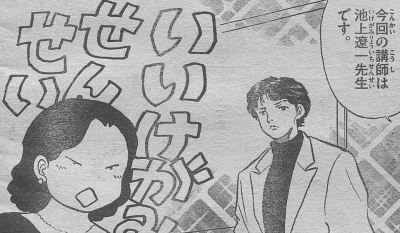Notes:
- Kashi-hon (貸本) is a Japanese phrase for books and magazines that are rented out.
- Adachi's older brother mentioned in the story is Tsutomu Adachi (あだち勉), a manga artist in his own right. He was an assistant to the legendary mangaka Fujio Akatsuka (赤塚 不二夫) and was instrumental in shaping the destiny of his younger brother Mitsuru.
- Adachi lists his childhood favorite artists as: Takao Saito (Golgo 13), Shinji Nagashima (Hanaichi Monme), Kazuo Umezu (The Drifting Classroom), Yu Takita (Terajima-cho), Shigeru Mizuki (GeGeGe no Kitaro), Hiroshi Hirata (Satsuma Gishiden), Yoshiharu Tsuge (Screw Style), and Eiichi Arikawa (Mitsuyoshi Sonoda) (Sangokushi).
- "My father was a doctor. He was also very good at drawing." - Takahashi's father was a medical doctor. After her own success she published a book of his drawings of kappa.
- The film that Rumiko Takahashi saw as a child that had such an impact on her was Anju to Zushiomaru (安寿と厨子王丸) released in English as The Orphan Brothers. This an anime film released by Toei on July 19, 1961, sees the story of Anju and Zushio, children separated from their parents and sold into slavery after their father is framed for a crime he did not commit and their mother is evicted from their land. The children struggle through many hardships in hopes of being reunited with their parents. Takahashi relates this story in an interview she did with mangaka Hiromu Arakawa.
- Songo-kun (そんごくん) by Fujio Akatsuka is mentioned by Takahashi as the first manga she could mentally follow and remember.
- Takahashi draws a number of manga characters that were a part of her childhood. She includes the the brothers from Fujiko Akatsuka's Osomatsu-kun (おそ松くん) alongside Chibito, Dayon and Iyami from the same series. The animals from Osamu Tezuka's Wonder Three (ワンダー3), Akko from The Secrets of Akko-chan (ひみつのアッコちゃん), Sapphire from Princess Knight (リボンの騎士), Astro from Astro Boy (鉄腕アトム), Q-Taro, Doronpa and P-ko from Obake no Q-Taro (オバケのQ太郎), Leo from Jungle Emperor Leo (劇場版 ジャングル大帝).
- Gakunenshi (Published by Shogakukan) are "school year magazines" (with titles like "First Grader," "Second Grader," etc.).
- The issue of Garo that Takahashi read as a child was the 1967 No. 36 issue.
- All Night Nippon (オールナイトニッポン) is a four hour, nightly radio show broadcast by Nippon Broadcasting System. It has aired since October 1, 1967 and still airs today.
- "Puck in Music" is another radio show on TBS.
- Shonen Sunday and Shonen Magazine are both referenced continually in this story. While Shonen Jump is the king of weekly comics for boys in Japan nowadays, the 60s, 70s and early 80s were dominated by the rivalry of Sunday and Magazine.
- Yokoo Tadanori is a famous graphic designer/artist who contributed numerous eye-catching covers to Shonen Magazine in the 70s.
- Ikari yo Saraba (怒りよさらば) is a three chapter story in Shonen Sunday. Takahashi specifically mentions discovering it in the second of the three chapters which would put it in Shonen Sunday 1971 Vol. 4-5.
- Orochi (おろち) by Kazuo Umezu and Zeni Geba (銭ゲバ) by George Akiyama were mentioned as big hits for Shonen Sunday in this era.
- Kutabare! Namida-kun (くたばれ!!涙くん) by Isami Ishii ran for 8 volumes and was featured Mitsuru Adachi as an assitant on the title.
- "With my spare change I got Sunday, Magazine, King, Champion, GORO and Big Comic Original." - Takahashi herself would later publish in Shonen Sunday, Big GORO, and Big Comic Original.
- "This is the Magazine Generation." - Ashita no Joe, Yakyuyo no Uta, Devilman, and Ai to Makoto were all being published in Shonen Magazine at this time.
- Nine was Adachi's first manga that was entirely written and drawn by him.
- Hitari Ryoko was published in Shojo Comics, Miyuki was published in Shonen Big Comics, and Touch was in Shonen Sunday.
- Shonen Sunday 1982 Issue 27 features the first interview between Mitsuru Adachi and Rumiko Takahashi, which we host on the site.
- Kazuo Koike's Gekiga Sonjuku produced other talented artists and writers like Yuji Horii, Hideyuki Kikuchi, Keisuke Itagaki, Tetsuro Hara, Marley Caribu and Naoki Yamamoto.
- The pictured face that Takahashi makes when she sees Ryoichi Ikegami is called a "diamond-shaped mouth" (ひし形の口/hishigata no kuchi). This comical expression has been used by Takahashi since the 2000s, however it did not originate with her. It was frequently used by the Tamanegi (the Onion Squad) in Mineo Maya's Patalliro! (パタリロ!) and Toshi-chan from Tsubame Kamogawa's Macaroni Horenso (マカロニほうれん荘).
- "I used up my spring break and submitted a 32 page SF comedy." - This would be Takahashi's debut work Katte na Yatsura (勝手なやつら).
- Takahashi mentions being a temporary assistant for Kazuo Umezu, working at his studio for three days on Makoto-chan.
- "I'm actively visualizing my new series." - This was published between the end of Inuyasha and before the debut of Kyokai no RINNE.
- Akasaka (赤坂) is a residential and commercial district of Minato, Tokyo, Japan.
|



